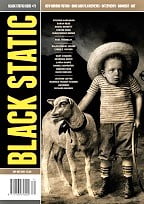 Black Static #71, September/October 2019
Black Static #71, September/October 2019
“Dixon Parade” by Stephen Hargadon
Reviewed by Victoria Silverwolf
The stories in the latest issue of this British magazine of dark fantasy and horror feature characters haunted by their pasts, in very different ways.
The narrator of “Dixon Parade” by Stephen Hargadon is a man whose wife leaves him for another man after decades of marriage. He retreats into solitude, only occasionally in contact with his adult children. On a journey to a village they often visited in happier times, he purchases a painting from a shop never seen before. A strange figure appears in one of the windows in the picture. The man tracks down the place that the painting portrays, leading to an extraordinary encounter.
The narrator is a fully developed character, and the author makes the world in which he lives very real. This makes the fantastic elements in the plot as believable as the ordinary ones. This is a subtle story, which lingers in the reader’s mind. It strikes a perfect balance between being transparent and being opaque. This translucent nature, and the quietly disturbing mood of the story, remind me of the strange tales of Robert Aickman, which is very high praise indeed.
The main character in “Diamond Saw” by Sarah Read is an assassin, working as a prostitute in order to gain access to her target. The man proves to be just as deadly as she is, leading to a violent conclusion.
What makes this story fantasy is the fact that the woman is in the early stages of pregnancy, and her unborn child speaks to her in the voice of her dead father, urging her on in her mission. The premise is a unique one, but it does not always blend successfully with crime fiction.
In “Residue” by Steven Sheil, a woman cleans out the apartment left behind by her brother, who has just died of a terminal illness. The most difficult job is defrosting the refrigerator, which has built up thick layers of ice. Signs that someone else is in the apartment appear, and the woman suffers from an incident that brings back an unpleasant memory of the past.
The first part of this story is intriguing, and written in a visceral way that makes the filthy apartment almost a character in the plot. Unfortunately, the second part is a more familiar kind of ghost story. The woman’s battle with the ice in the refrigerator is more interesting than her other, more serious struggles.
The narrator of “A Pressed Red Flower in the Abandoned Archive” by Daniel Bennett becomes obsessed with a list of seemingly random phrases that appear in a computer file. Some of these appear to relate to events in the narrator’s past. The mystery causes the narrator to withdraw from ordinary life, constantly studying the phrases in a doomed attempt to understand them.
The idea is intriguing, but leads to an inconclusive ending. The narration alternates with examples of the phrases. These create an evocative mood, in the manner of found poetry, but leave the reader as bewildered as the narrator.
In “Other Houses” by Seán Padriac Birnie, a woman has memories that do not match those of her sister or her deceased father. As an example, she remembers pushing her sister into a pond when they were both children. Their father always denied this, and the sister says she fell in on her own. The most compelling memory is of a stairway, leading nowhere, in a downstairs cupboard. The sister insists that such a thing never existed.
Adding to her concern is the fact that the dog she had as a child suddenly vanished, without explanation. There is also the camera that their father left behind when he died, containing photographs of things that could not have happened. Investigating the downstairs cupboard, she discovers an explanation for all of this, and has a final, disturbing experience.
An early reference to the Narnia books of C. S. Lewis, as well as other clues, make it clear to the reader that this is a dark version of a portal fantasy. The reader realizes this long before the protagonist does, lessening the suspense. Although the author writes very well, he has difficulty sustaining the mood of mystery for the entire length of his novelette.
Victoria Silverwolf notes that the lead story contains a reference to the 1975 British horror film From Beyond the Grave, which is quite good.